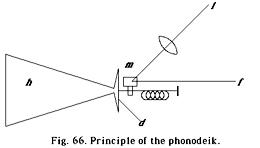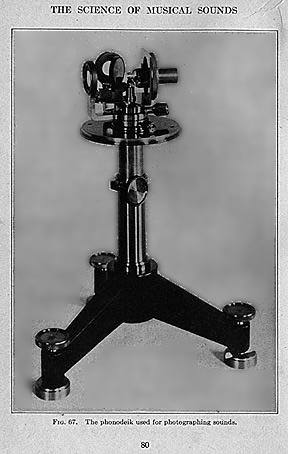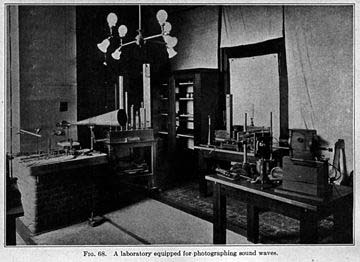Private lessons available in person in San Diego, or online using Discord: composition, music-theory, tuning-theory, piano, and all woodwinds (sax, clarinet, flute, bassoon, recorder). Current rates US$ 80 per hour (negotiable). Send an email to: monzojoe2 (AT) gmail. Also please consider making a donation to Tonalsoft using the PayPal button at the bottom of this page. Thank you.
Phonodeik
The phonodeik was an apparatus invented in 1908 by Dayton Clarence Miller, author of The Science of Musical Sounds (1916, 2nd ed. 1922), to graphically show the waveform of a sound, either recorded onto photographic paper or projected onto a screen. The phonodeik and similar early devices were superceded by the electronic oscilloscope still used today, which only became practical in 1931 with the invention of a sealed high-vacuum cathode-ray tube (CRT) by V. K. Zworykin
The 1st edition of Miller's book was very likely the inspiration for Harry Partch to begin his experiments with sound and just-intonation (see McLaren, The Evolution of Harry Partch's Tuning System). The Phonodeik is described in detail in the following lecture which appears as Chapter 3 of Miller's book.
LECTURE III
METHODS OF RECORDING AND PHOTOGRAPHING
SOUND WAVES
THE PHONODEIK
For the investigation of certain tone qualities referred to in Lecture VI, the author required records of sound waves showing greater detail than had heretofore been obtained. The result of many experiments was the development of an instrument which photographically records sound waves, and which in a modified form may be used to project such waves on a screen for public demonstration; this instrument has been named the "Phonodeik," meaning to show or exhibit sound. [references: The phonodeik. D.C. Miller, Physical Review, 28, 151 (1909); Proc. British Association for the Advancement of Science, Winnipeg (1909), p. 414; Proc. British Association for the Advancement of Science, Dundee (1912), p. 419; Engineering, London, 94, 550 (1912). pp. 36-49, 372; Vorlesungen, S. 246. Rayleigh, Theory of Sound, II, pp. 170-235.]
The sensitive receiver of the phonodeik is a diaphragm, d, Fig. 66, of thin glass placed at the end of a resonator horn h; behind the diaphragm is a minute steel spindle mounted in jeweled bearings, to which is attached a tiny mirror m; one part of the spindle is fashioned ino a small pulley; a few silk fibers, or a platinum wire 0.0005 inch in diameter, is attached to the center of the diaphragm and being wrapped once around the pulley is fastened to a spring tension piece.

Light from a pinhole l is focused by a lens and reflected by the mirror to a moving film f in a special camera. If the diaphragm moves under the action of a sound wave, the mirror is rotated by an amound proportional to the motion, and the spot of light traces the record of the sound wave on the film.
In the instrument made for photography, Fig. 67, the usual displacement of the diaphragm for sounds of ordinary loudness is about half a thousandth of an inch, resulting in an extreme motion of one thousandth of an inch, which is magnified 2500 times on the photograph by the mirror and light ray, giving a record 2 1/2 inches wide; the film commonly employed is 5 inches wide, and the record is sometimes wider than this. The extreme movement of the diaphragm of a thousandth of an inch must include all the small variations of motion corresponding to the fine details of the wave form which represent musical quality.

Many of the smaller kinks shown in photographs in this book are produced by component motions of the diaphragm of less than one hundred-thousandth of an inch; the phonodeik must faithfully reproduce not only the larger and slower components, but also those minute vibrations which have a frequency of perhaps several thousand per second.
The camera is arranged for moving films of 5 inches in width and of lengths to 100 feet; there are three separate revolving drums having circumferences of 1, 2, and 5 feet respectively; there is also a pair of drums, each holding 100 feet of film, arranged for winding the film from one to the other during exposure. The single drums are turned by an electric motor, with film speeds varying from 1 to 50 feet per second.
Besides the record of the wave there are photographed on the film simultaneously a zero line to give the axis of the curve for analysis, and time signals from a stroboscopic fork, 1/100 second apart, to enable the exact determination of pitch from measurements of the film.
A sound-recording instrument might best be used out of doors, on the roof of a building for instance, to avoid confusion of the records by reflection from the walls; since it is not convenient to work in such a place, the disturbing factors of the laboratory room are minimized by various precautions, such as padding the walls with thick felt; Fig. 68 shows the room in which the photographs are made; the phonodeik with the receiving horn stands on a pier, while the light and moving-film camera are behind the screen. The tuning fork which flashes the time signal is shown at the right.

RETRIEVED FROM THE INTERNET ARCHIVE ON 18:29:26 Oct 17, 2024
